Uniforms of military personnel. Military uniforms of soldiers and officers of the second world war
Military Official's Tunic
Throughout its history, the Russian military uniform has undergone many changes, improvements and innovations. This was due to the will of the ruler, a change in ideology, the influence of Western European military fashion.
Most Russian emperors were adherents of military fashion Western Europe, therefore, the Russian military uniform was often similar to the uniforms of other European armies. And only Emperor Alexander III gave the military uniform the appearance of a national dress.
Pre-Petrine era
In Russia before late XVII v. there were almost no permanent troops, so there were no military uniforms either. The princes' squads were dressed in the same clothes as civilians, only armor was added.
True, some princes sometimes acquired uniform clothing for their squads, but these were isolated cases.
The government of Tsar Michael in 1631, awaiting war with Poland, sent Colonel Alexander Leslie to Sweden to hire 5,000 infantry soldiers.
In the 17th century, during the reign of Alexei Mikhailovich, "Regiments of a foreign system" were formed - military units formed from "eager" free people, Cossacks, foreigners and others, and later from ordinary people on the model of Western European armies.
The first unified military uniform in Russia can be considered the clothing of the rifle regiments. They appeared in the 17th century.
Sagittarius
Sagittarius- a serviceman; a rider or infantryman armed with a "fiery battle". The archers in Russia made up the first regular army.
The rifle regiments had a uniform and obligatory ceremonial uniform (“colored dress”). It consisted of an upper caftan, a hat with a fur band, trousers and boots, the color of which (except for trousers) was regulated in accordance with the belonging to a particular regiment.
Caftan- top men's clothing.
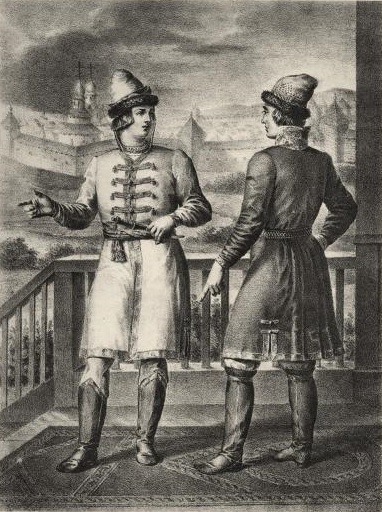
Common in the weapons and clothing of all archers:
- gloves with leggings of brown leather;
- on the march the muzzle was squeaky or the musket was covered with a short leather cover;
- the reed was worn behind the back over any shoulder;
- a sash was put on over the waist belt;
- there were no buttonholes on the marching caftan;
- external distinction of senior officers (" initial people») There was an image of a crown on a cap and a staff embroidered with pearls, as well as an ermine lining of the upper caftan and the edge of the cap (which indicated a noble princely origin).
The dress uniform was worn only in special days: during major church holidays and special occasions.
Everyday and in military campaigns, a "wearable dress" was used, which had the same cut as the dress uniform, but made of a cheaper cloth of gray, black or Brown color.
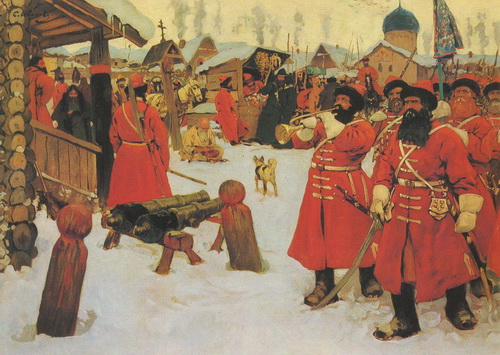
S. Ivanov "Sagittarius"
During the struggle for power, the rifle regiments opposed Peter I and were repressed by him. The form of the European model in Russia was introduced by Peter I, basically borrowing it from the Swedes.
The era of Peter I
Peter I created a regular army on the basis of the "Regiments of the foreign system" that existed during the reign of his father, and the streltsy units. The army was recruited on the basis of conscription (compulsory service of the nobles was also preserved until the middle of the 18th century). Peter inherited from his predecessors an army already adapted for further reconstruction. In Moscow there were two "elective" regiments (Butyrsky and Lefortovsky), which were commanded by "foreigners" P. Gordon and F. Lefort.
In his "amusing" villages, Peter arranged two new regiments: Preobrazhensky and Semyonovsky, completely according to a foreign model. By 1692, these regiments were finally trained and made up the 3rd Moscow elective regiment, headed by General A.M. Golovin.

Officer of the Semyonovsky Life Guards Regiment from 1700 to 1720
At first, the officer's uniform of the Petrine army was no different from the soldier's. Then they introduced a "commander's insignia" - an officer's scarf. This detail was borrowed from the Swedes, with the exception of the coloring, which reproduced the colors of the Russian flag. According to the rules, the scarf was worn over the right shoulder and tied at the left hip, but our officers adapted to wear it around the waist - it was more comfortable in battle. The Petrovsky scarf with changes has survived to the present - in the form of a ceremonial officer's belt.
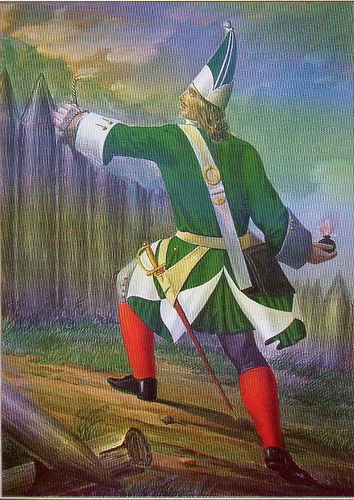
Grenadier of an infantry regiment from 1700 to 1732
The armament of each soldier consisted of a sword with a sword belt and a fuse. Fusey - a gun, the Fusée's castle was flint; sat on the fusee in necessary cases baguette is a five- or eight-point three-edged bayonet. The cartridges were placed in leather bags attached to the sling.
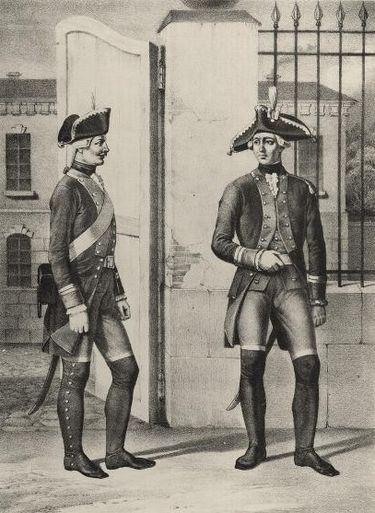
Captenarmus and Ensign of the Musketeer Companies of the Infantry Regiment from 1763 to 1786
Captenarmus and the sergeants were armed with halberds instead of fuzei - axes on a three-articulated shaft.

Sergeant of the Infantry Regiment with a halberd from 1700 to 1720
One of the companies in each regiment was called a grenadier, and a feature of its armament was the fuse bombs, which were kept by the grenadier in a special bag. Grenadiers- selected units of infantry and / or cavalry, designed to storm enemy fortifications, mainly in siege operations.
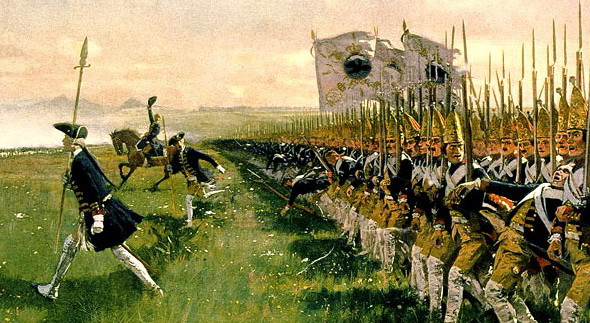
Dragoons- the name of the cavalry (cavalry), which is also capable of operating on foot. Dragoons in Russia were horse and foot service.

Fanen-cadet of the Nizhny Novgorod Dragoon regiment, 1797-1800
Since 1700, the uniform of a soldier consisted of a small flattened bright cocked hat, a caftan, an epanchi, a camisole and trousers.
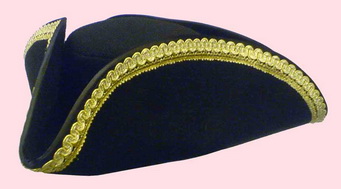
Cocked hat
Epancha- a wide sleeveless round cloak with a hood for men, and for women - a short, sleeveless coat (obepanechka). Imported from the Arab East.
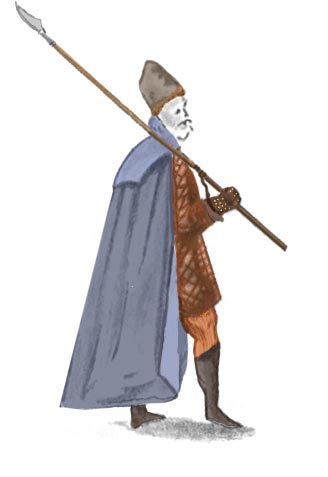
Camisole- men's clothing, sewn at the waist, knee-length, sometimes sleeveless worn under a caftan.

The hat was black, the edges of the brim were trimmed with braid, and a brass button was attached to the left side. When listening to orders from the elders, the younger ones took off their hat and held it under their left armpit. The soldiers and officers wore hair long to the shoulder, and on ceremonial occasions they powdered it with flour.
The infantrymen's caftans were of green cloth, the dragoons were of blue, single-breasted, without a collar, with red cuffs (a lapel on the sleeve of men's clothing).
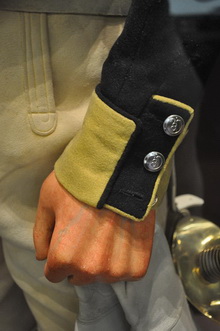
Cuff of the 8th cuirassier regiment of the French army (1814-1815)
The caftan was knee-length and was supplied with brass buttons; The epancha for cavalry and infantry was made of red cloth and had two collars: it was a narrow cape that reached the knees and did not protect well from rain and snow; boots - long, with light sockets (funnel-shaped expansion) were worn only on guard and during the campaign, and stockings and blunt-nosed greasy heads with a copper buckle were ordinary shoes; army soldiers had stockings Green colour, and among the Transfiguration and Semyonovites after the Narva defeat - red, according to legend, in memory of the day when the former "amusing" regiments did not flinch, with general "confusion" under the onslaught of Charles XII.
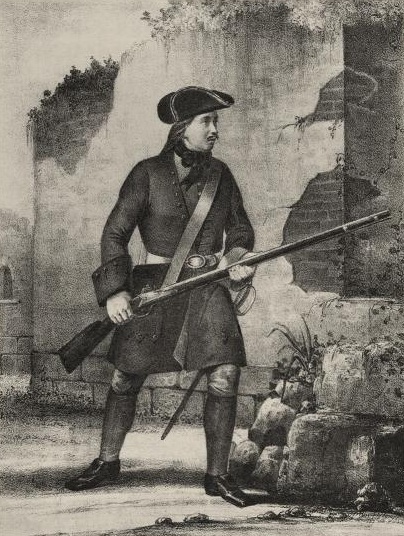
Fuzeler of the Semenovsky Life Guards Regiment, from 1700 to 1720
The guard grenadiers differed from the fusiliers (soldiers armed with flintlock rifles) only in a headdress: instead of a triangular hat, they wore leather helmets with an ostrich feather.
The cut of the officer's uniform was the same as that of the soldiers, only trimmed around the edges and along the side with gold galloon, the buttons were also gilded, the tie, instead of black cloth, like the soldiers, was white linen. Attached to the hat plume made of white and red feathers.
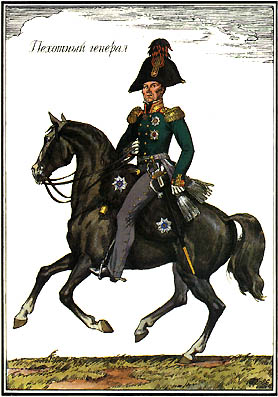
Infantry general with a plumed hat
In full dress, officers were required to have powdered wigs on their heads. He also distinguished the officer from the private with a white-blue-red scarf with silver tassels, and the headquarters officer with gold tassels, which was worn high on his chest, at the collar.
Under Peter I in Russia, epaulettes also appeared on military clothing. The shoulder straps have been used as a means of distinguishing the servicemen of one regiment from the servicemen of another regiment since 1762, when shoulder straps of various weaving from a yarn cord were installed for each regiment. At the same time, an attempt was made to make the shoulder strap a means of distinguishing between soldiers and officers, for which in the same regiment officers and soldiers had different weaving of shoulder straps.
In the future, the form of uniforms changed, although in general the samples of Peter the Great were preserved, which became more and more complicated. After Seven Years War the cult of Frederick the Great was formed. Convenience in the form of uniforms was forgotten; they tried to make the soldier look good and give him such an outfit that the maintenance of which would take all his free time from service in order. Especially a lot of time was required for the soldiers to keep their hair in order: they were combed into two curls and a braid, they were powdered on foot, and on horseback it was allowed not to powder the hair and not curl it in curling, taking it into one dense braid, but it was required to grow and brush your mustache high or, who does not have one, have fake ones.
The soldier's clothes were narrow, which was caused by the requirement of the then stance and especially marching without bending the knees. Many units of the troops had moose trousers, which were moistened and dried in public before being put on. This uniform was so inconvenient that in the instruction for training, the recruit was instructed to put it on no earlier than three months later, in order to teach the soldiers how to use such clothes.
The era of Catherine II
During the reign of Catherine II, the uniform was not followed very carefully. The guards officers were weary of it and did not wear it at all outside the formation. It was changed at the end of Catherine's reign at the insistence of Prince Potemkin. He said that “curling, powdering, weaving braids - is this a soldier's business? Everyone must agree that it is more useful to wash and scratch your head than to burden it with powder, bacon, flour, hairpins, and braids. The soldier's toilet should be such that it is up and ready. " The uniform of the army was simplified and consisted of a wide uniform and trousers tucked into high boots; the cocked hat was replaced for the soldiers by a helmet with a longitudinal ridge, which well protected the head from a saber strike, but did not save from the cold.
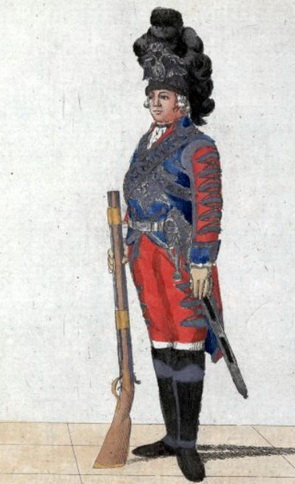
Cavalier in full dress (1793)

Private and chief officer of an infantry regiment in the form of 1786-1796.
But in the cavalry, and especially in the guards, the uniform remained shiny and uncomfortable as before, although complex hairstyles and leggings disappeared from the usual uniform of the troops.
The era of Paul I
Paul I carried out his own army reform, because discipline in the regiments suffered, ranks were handed out undeservedly (noble children from birth were assigned to a rank, to a particular regiment. Many, having a rank and receiving a salary, did not serve at all). Paul I decided to follow Peter the Great and take as a basis the model of a modern European army (Prussian), seeing in it an example of discipline and perfection. Military reform was not stopped even after Paul's death.
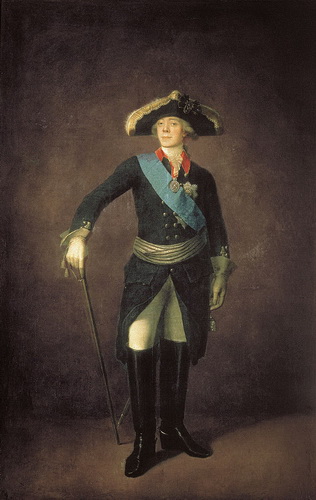
S. Shchukin "Portrait of Emperor Paul I in a ceremonial uniform and a cocked hat"
The uniform consisted of a wide and long uniform with folds and a turn-down collar, narrow and short pants, patent leather shoes, stockings with garters and boot-like boots, and a small triangular hat. The shelves differed in the color of the collars and cuffs, but without any system, they were difficult to remember and poorly distinguished.
Hairstyles are gaining importance again - soldiers powder their hair and braid it in regular length braids with a bow at the end; the hairstyle was so complicated that hairdressers were brought into the army.
Powder is not gunpowder
Buckles are not guns
A scythe is not a cleaver
I am not a Prussian, but a natural hare!
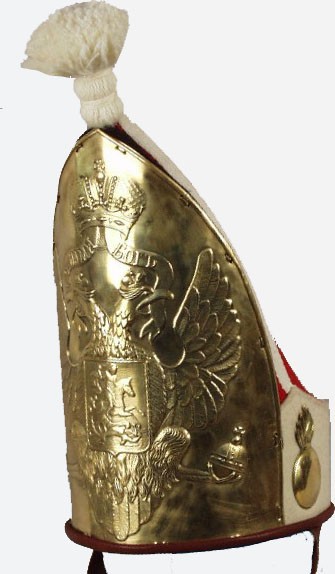
Grenadier of the Pavlovsk regiment
The grenadiers wore high cone-shaped caps (grenadiers) with a large metal shield in front; These hats, like a ceremonial headdress, were preserved in the Pavlovsky Life Guards regiment.
According to eyewitnesses, the soldiers on the march suffered most of all from lacquered shoes and tight trousers, which rubbed their legs.
The era of Alexander I
Emperor Alexander I was a supporter of a magnificent military uniform, which became even more uncomfortable. The Pavlovsk form in 1802 was replaced by a new one. Wigs were destroyed, boots and shoes were replaced with boots with trouser clasps; the uniforms were significantly shortened, narrowed and looked like tailcoats (the coattails on the uniforms were left, but the soldiers had them short); solid standing collars and shoulder straps and epaulettes were introduced; the officers' collars were decorated with sewing or buttonholes and were generally colored; the shelves were distinguished by their colors. Light and comfortable cocked hats were replaced by new hats, tall, heavy and very uncomfortable; they wore common name shakos, while the straps on the shakos and the collar rubbed the neck.
Shako- a cylindrical military headdress, with a flat top, with a visor, often decorated with a sultan. Was common in many European armies early XIX century.
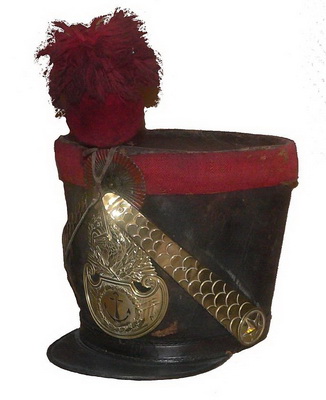
The highest command personnel were assigned to wear the then popular bicorns of huge sizes with feathers and edging. In winter, it was warm in the two-cornered hat, but in summer it was very hot, so the peakless cap also became popular in the warm season.
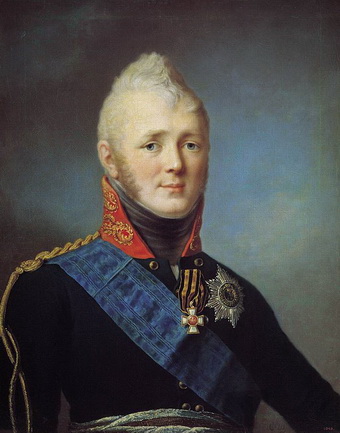
S. Shchukin "Alexander I in the uniform of the Preobrazhensky Life Guards Regiment"
Shoulder straps were first introduced only in the infantry (red), then the number of colors was brought to five (red, blue, white, dark green and yellow, in the order of the regiments of the division); officer's shoulder straps were trimmed with galloon, and in 1807 they were replaced with epaulettes.
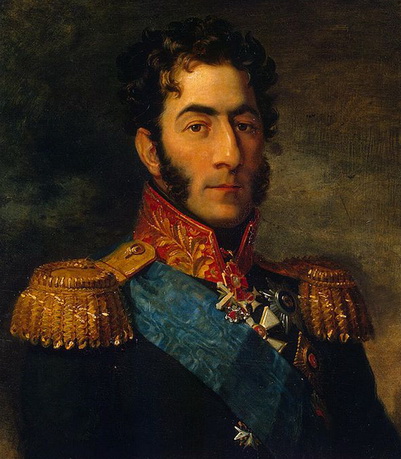
D. Dow "Portrait of General Peter Bagration with epaulets"
Epaulettes- shoulder insignia military rank on a military uniform. Were common in armies European countries in the XVIII-XIX centuries, especially during the Napoleonic wars. By the middle of the 20th century, they practically went out of circulation.
Subsequently, epaulettes were also given to the lower ranks of some cavalry units.
Pavlov's cloaks were replaced by narrow overcoats with standing collars that did not cover the ears. The equipment included a mass of belts, which was difficult to maintain. The uniform was complex and heavy to wear.
From the day of accession to the throne of Alexander I until 1815, officers were allowed to wear a particular dress outside of service; but at the end overseas trip due to fermentation in the army, this right was canceled.
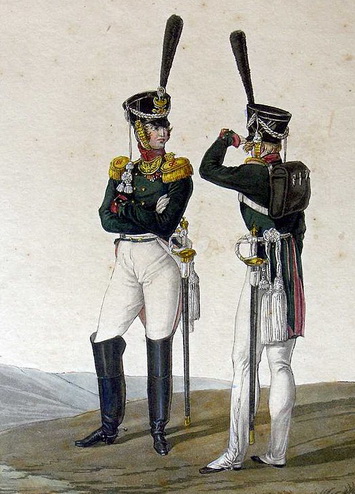
Staff officer and chief officer of the grenadier regiment (1815)
The era of Nicholas I
Under Nicholas I, uniforms and overcoats were at first still very narrow, especially in cavalry - officers even had to wear corsets; you couldn't put anything under your overcoat. The collars of the uniform were fastened tightly and strongly propped up the head. The shakos were too tall, during parades they were decorated with sultans, so that the entire headdress was about 73.3 cm high.
Wide trousers (woolen in winter and linen in summer) were worn over boots; under them, boots with five or six buttons were put on, since the boots were very short. The ammunition of white and black lacquered belts required constant cleaning. A huge relief was the permission to wear, first out of order, and then on the march, caps similar to the present ones. The variety of forms was great.

Chief Officer of the Volyn Life Guards Regiment (1830)
Only from 1832 did simplifications in the form of uniforms begin: in 1844 heavy and uncomfortable shako was replaced by high helmets with a sharp top, officers and generals began to wear caps with visors; the troops were supplied with mittens and headphones. Since 1832, officers of all types of weapons have been allowed to wear mustaches, and officers' horses are not allowed to trim their tails or trim their heads.
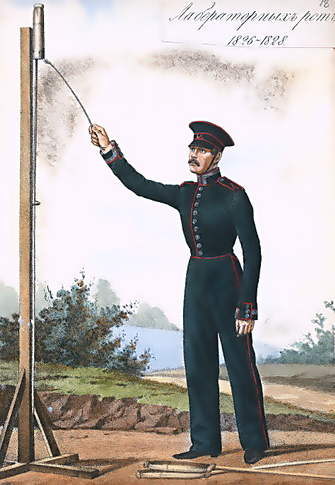
Non-commissioned officer of laboratory companies (1826-1828) - cap with visor
V last years of the reign of Nicholas, the uniform acquired instead of the French Prussian cut: ceremonial helmets with ponytails were introduced for officers and generals, uniforms for the guards were sewn from dark blue or black cloth, coattails on army uniforms became short, and white trousers became sew on red stripes, as in the Prussian army.
In 1843, on the soldier's shoulder straps, transverse stripes were introduced - stripes, according to which ranks were distinguished.
In 1854, shoulder straps were also introduced for officers. Since that time, the gradual displacement of epaulettes by shoulder straps began.
The era of Alexander II
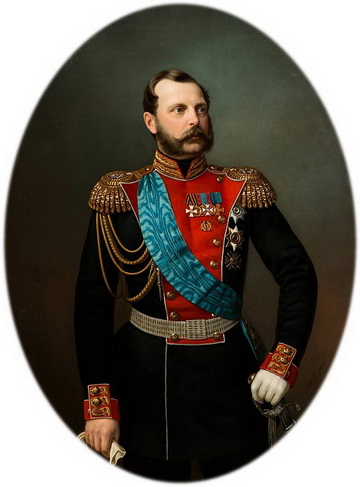
I. Tyurin "Alexander II in the form of the Preobrazhensky Life Guards Regiment"
The troops received a convenient form of uniform only during the reign of Emperor Alexander II. She had a beautiful and spectacular look and was at the same time spacious and allowed the insulation to be pushed on in cold weather. In February 1856 tailcoat-like uniforms were replaced by full-skirt uniforms. The cavalry retained the shiny uniforms and their colors, but the cut was made more comfortable. All received spacious overcoats with a turn-down collar that covered the ears with fabric buttonholes; the collars of the uniforms were lowered and widened.
The army uniform was first double-breasted, then single-breasted. Trousers were worn in boots only on a campaign, then at the lower ranks always; in summer, the trousers were made of linen.
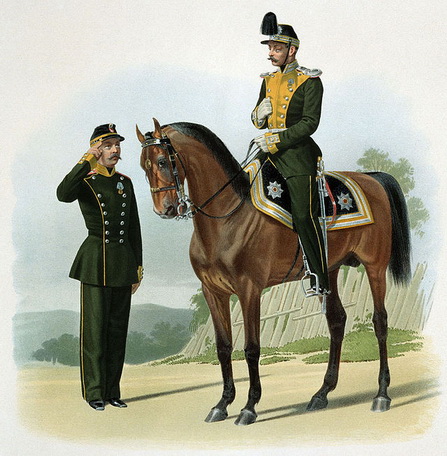
Private and adjutant of the Life Guards of the Lithuanian Regiment (in everyday life and dress uniforms), 1862
Beautiful, but uncomfortable helmets remained only with the cuirassiers and the guard, who, in addition, had caps without visors. The ceremonial and ordinary headdress was a cap. Lancers continued to wear diamond-topped shakos.
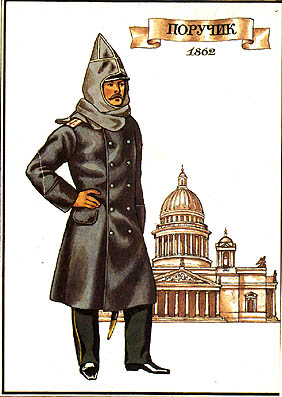
A convenient and practical hood was introduced, which helped the soldier in the winter. Satchels and bags were lightened, the number and width of straps for carrying them were reduced, the soldier's burden was lightened.
The era of Alexander III

I. Kramskoy "Portrait of Alexander III"
By the early 70s of the XIX century. hair cut was required short. The uniforms of this era were quite comfortable. The emperor strove to nationalize the military uniform. Only the Guards cavalry retained their former rich clothing. The new outfit was based on the uniformity and comfort of wear and fit. The headdress, both in the guards and in the army, consisted of a low, round lamb's cap with a cloth bottom; the cap is decorated in the guards with the St. Andrew's star, in the army - with the coat of arms.

Cossack of the Ural Cossack army, chief officer of the Life Guards of His Majesty's Cossack regiment and adjutant general of the Cossack troops (1883)
A uniform with a standing collar in the army with a straight back and a side without any edging was fastened with hooks, which could be freely altered by widening or narrowing the uniform. The guards uniform had an oblique side with edging, a colored high collar and the same cuffs; the uniform of the cavalry, with its transformation exclusively into dragoon regiments (except for the guards), became similar to the uniform of the infantry, only somewhat shorter.
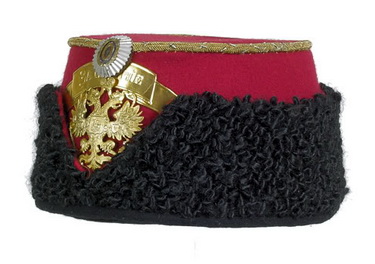
Lamb ceremonial hat
The lamb's ceremonial hat resembled an ancient boyarka. Wide trousers tucked into high boots. In the army, greatcoats were fastened with hooks so that in sunny weather a shiny object would not draw the attention of the enemy and cause fire. For the same reason, sultans and helmets with shiny coats of arms were canceled. In the guard, greatcoats were fastened with buttons. In the infantry and other types of weapons, caps with bands were introduced, the difference between one regiment from another was based on a combination of colors of shoulder straps and bands. The division from the division differed in numbers on the shoulder straps.

V. Vereshchagin "Officer of the line battalion in a white jacket and red trousers"
Alexander II introduced tunics and linen shirts for wearing in hot weather, and Alexander III made sure that the soldier's uniform resembled peasant clothes. In 1879, a shirt with a stand-up collar was introduced for soldiers, like a shirt-shirt.
The era of Nicholas II
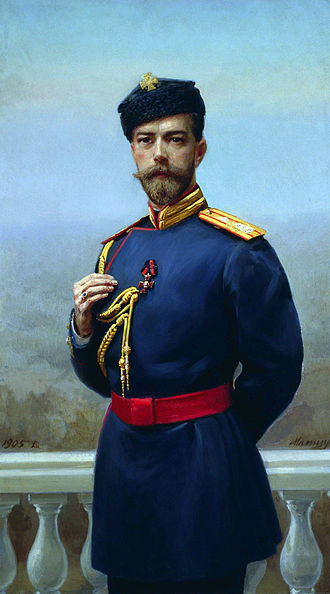
G. Manizer "Portrait of Emperor Nicholas II in the uniform of the 4th Infantry Imperial Family of the Life Guards Regiment with the insignia of the Order of St. Vladimir IV degree"
Emperor Nicholas II almost did not change the uniforms. The uniforms of the guards cavalry regiments of the era of Alexander II were only gradually restored. The officers of the entire army were given a galloon (instead of a simple leather, introduced Alexander III) shoulder harness.
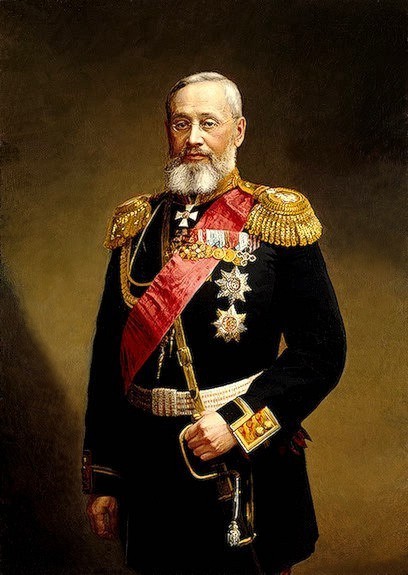
A. Pershakov “Portrait of P.S. Vannovsky "(the harness is visible)
For troops southern districts the ceremonial headdress was considered too heavy and was replaced by an ordinary cap, to which a small metal coat of arms is attached.
Most significant changes followed only in the army cavalry. The modest uniform without buttons at the beginning of the reign of Nicholas II was replaced by a more beautiful double-breasted uniform, sewn at the waist and with colored piping along the side. The shako was introduced for the guards regiments.
In each cavalry division, regiments are given the same colors: the first is red, the second is blue, and the third is white. The previous colors remained only in those shelves for which some historical memory was associated with their color.

Ceremonial cap of the era of Nicholas II
The caps were also changed: they began to make colored crowns, not the bands, so that the color of the regiment could be seen at a great distance, and visors were given to all the lower ranks.
In 1907, following the results Russo-Japanese War in the Russian army introduced as summer uniform single-breasted khaki jacket with a stand-up collar on hooks, with a five-button fastening, with pockets on the chest and on the sides (the so-called "American" cut). The white jacket of the previous model is out of use.
Jacket of the Russian army of the era of Nicholas II
In aviation, on the eve of the war, a blue jacket was adopted as a workwear.
Front-line
A corporal (1) in a uniform of the 1943 model. The insignia from the buttonholes were transferred to the shoulder straps. The SSh-40 helmet became widespread since 1942. Around the same time, submachine guns began to arrive in the troops in massive quantities. This corporal is armed with a 7.62-mm Shpagin submachine gun - PPSh-41 - with a 71-round drum magazine. Spare magazines in pouches on a waist belt next to a pouch for three hand grenades. In 1944, along with the drum magazine for the PPSh-41, a 35-round horn magazine began to be produced, which was also suitable for the PPS-43. Carob magazines were carried in pouches in three compartments. Grenades were usually carried in pouches on a waist belt. By the beginning of the war, there were pouches for one grenade, in this case the F-1 (For) grenade is shown. More practical pouches for three grenades appeared later, shown is a pouch with a fragmentation grenade RG-42 (Зb). Pouches with two compartments were intended for high-explosive grenades RGD-33, here is shown a grenade with a fragmentation ring (Zs) on. The bag of the 1942 model had a design that was simple to the point of primitiveness. Each squad had an ax, which was carried by one of the soldiers on a waist belt in a special case (5). A new type of pot (6), similar to the German model. Enamel mug (7). Due to the lack of aluminum, the troops encountered glass flasks with a cork stopper (8). The glass of the flask could be green or brown, as well as transparent. Flasks were suspended from a waist belt by means of a cloth cover. The BN gas mask was equipped with a communication box and an improved TSh filter (9). Gas mask bag with two side pockets for spare eyepiece lenses and an anti-fog pencil. The pouch for spare ammunition was suspended on the back from the waist belt and held six standard five-shot both (10).
Rookie
Private (1 and 2) in a summer field uniform, model 1936, with insignia, model 1941. Helmet, model 1936, and boots with windings. Field equipment of the 1936 model, almost all equipment of this type was lost in the first year of fighting. The equipment includes a duffel bag, a roll-up with an overcoat and a raincoat, a food bag, ammunition pouches with two compartments, a sapper shovel, a flask and gas mask bag... The Red Army soldier is armed with a 7.62-mm Mosin rifle, model 1891/30. The bayonet is attached in the opposite direction for easy portability. Shown is a bakelite medallion (3), a sapper shovel with a case (4), an aluminum flask with a case (5), a cartridge belt for 14 rifle clips (6). In the future, instead of leather equipment, tarpaulin was produced. Each compartment of the cartridge pouch housed two five-shot clips (7). The idle pot (8) served both as a saucepan and as a bowl. Boots (9) with windings (10). BS gas mask with bag (11). The protrusion between the eye sockets made it possible to wipe the fogged glass from the inside and to clear the nose. The gas mask was equipped with a T-5 filter.
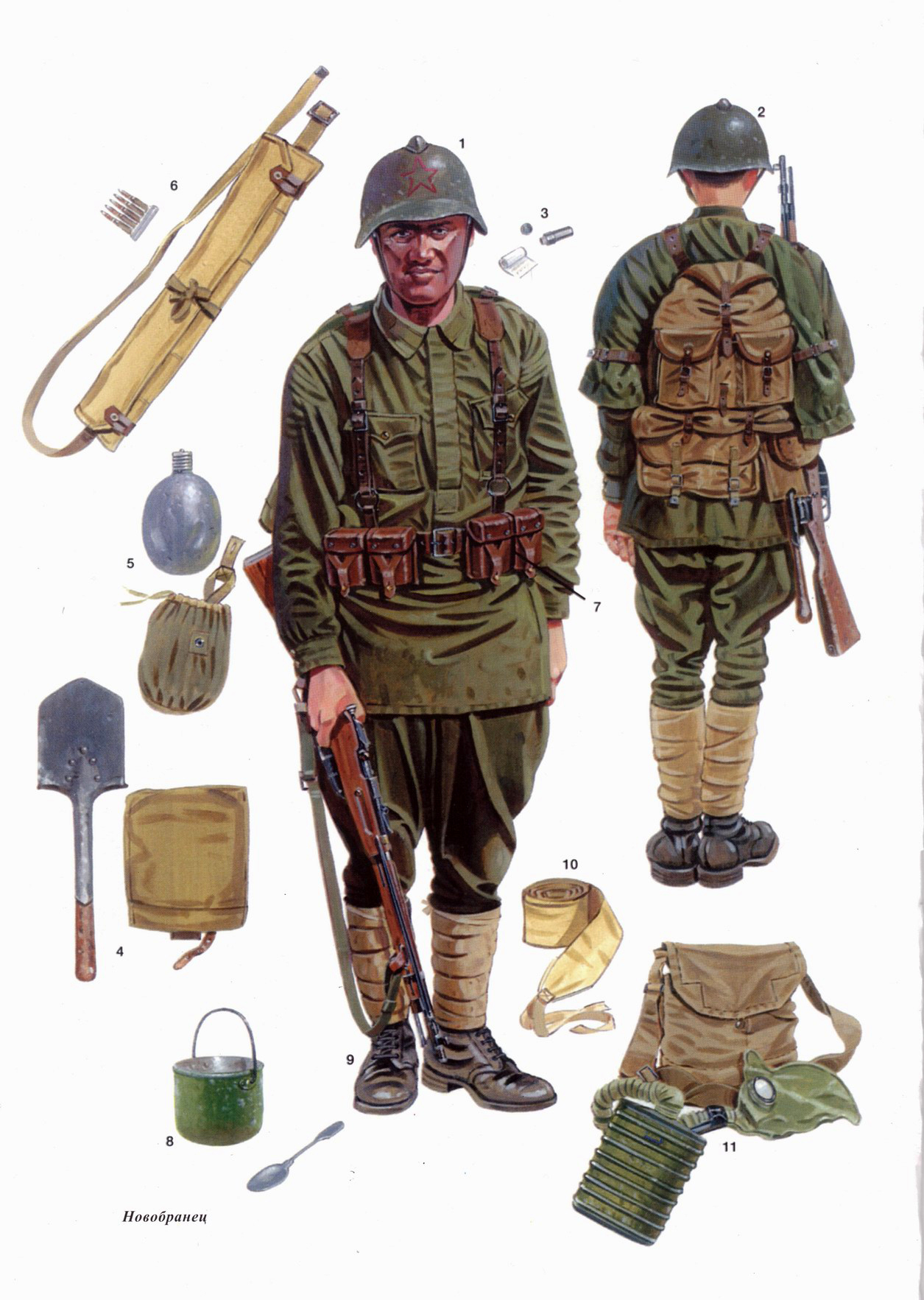
Uniform of a German corporal (non-commissioned officer), 1939-1940 01 - M-35 field jacket with a non-commissioned officer's emblem in 02 - M-35 steel helmet with Heeres marking 03 - Zeltbahn M-31 fabric camouflage tent "Splittermuster" 04 - gray ("Steingrau") trousers 05 - leather belt 06 - bags filters for a gas mask 07 - M-38 gas mask 08 - M-24 grenade 09 - black leather pouch 10 - M-31 aluminum bowler hat 11 - boots 12 - 7, 92 mm Mauser 98k 13 - Seitengewehr 84/98 bayonet 14 - sapper shovel
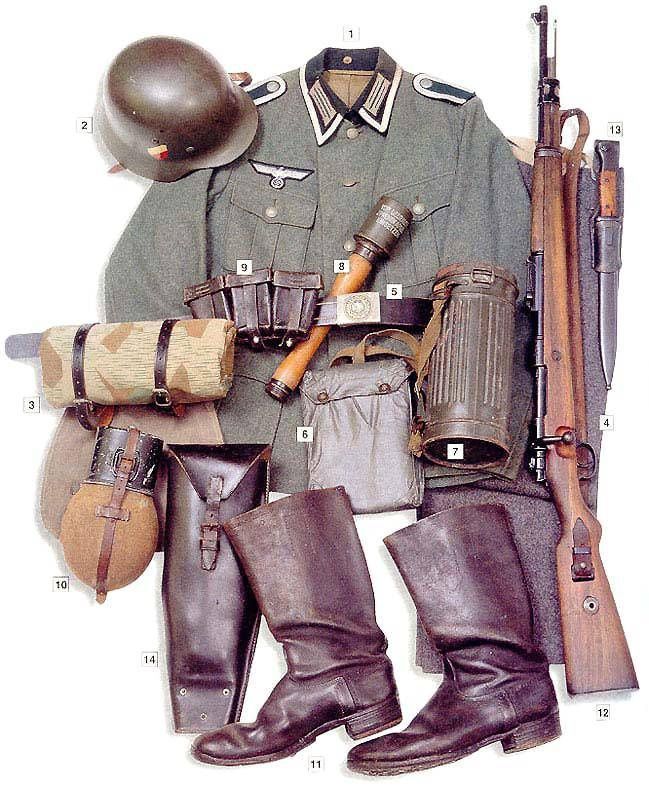
Lieutenant uniform of 82nd Airborne Sicilly, 1943 01 - M2 helmet with camouflage net 02 - M1942 jacket 03 - M1942 trousers 04 - M1934 wool shirt 05 - boots 06 - M1936 Harness belt with M1916 holster for Colt M1911 and pistol 07 - M1936 straps 08 - M1A1 carabiner 09 - M2A1 gas mask 10 - M1910 folding shovel 11 - M1942 bowler hat 12 - M1910 bag 13 - Tokens 14 - M1918 Mk I knife 15 - M1936 backpack
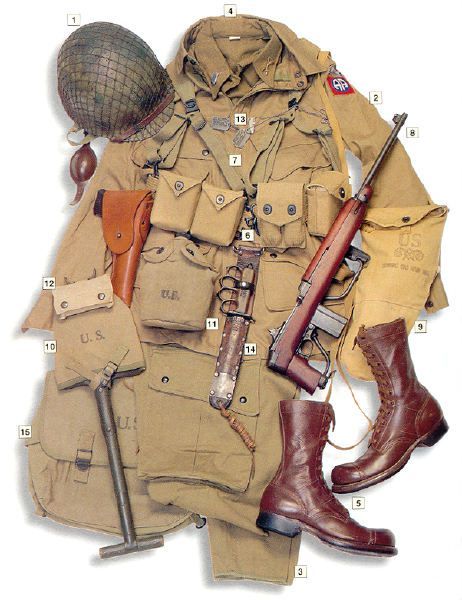
Luftwaffe Hauptmann uniform (captain), FW-190-A8 pilot, Jagdgeschwader 300 Wilde Sau, Germany 1944 01 - LKP N101 headphones 02 - Nitsche & Gunther Fl. 30550 goggles 03 - Drager model 10-69 oxygen mask 04 - Hankart 05 - AK 39Fl. compass 06 - 25 mm Walter Flarepistol M-43 with ammunition on the belt 07 - holster 08 - FW-190 parachute 09 - aviation boots 10 - M-37 Luftwaffe breeches 11 - Luftwaffe leather jacket with Hauptmann logo and Luftwaffe armband
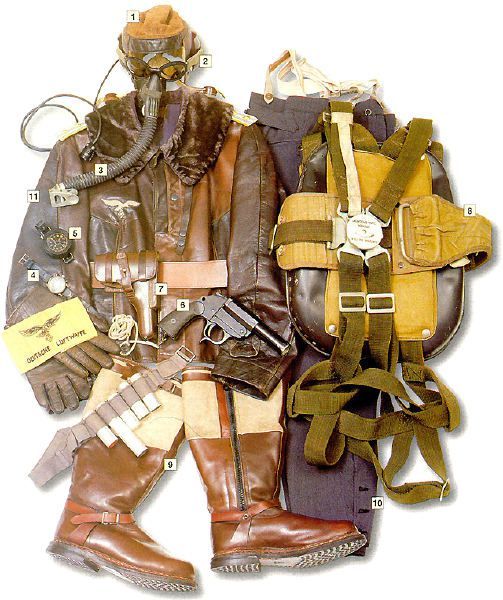
Private ROA (Vlasov army), 1942-45: 01 - Dutch field jacket with ROA on buttonholes and shoulder straps, Heeres an eagle on the right chest 02 - M-40 trousers 03 - medallion 04 - M-34 cap with ROA 05 - boots 06 - M-42 gaiters 07 - Grman unloading belt with a pouch 08 - M-24 grenade 09 - M-31 bowler hat 10 - Bayonet 11 - M-39 webbing 12 - M-35 helmet with a camouflage net 13 - " New life"Magazine for" eastern "volunteers 14 - 7.62 mm Mosin 1891/30 g

US Army infantry uniform 1942-1945: 01 - M1 helmet 02 - M1934 shirt 03 - M1934 sweatshirt 04 - M1941 trousers 05 - boots 06 - M1938 leggings 07 - M1926 lifebuoy 08 - M1937 ammunition belt 09 - M1924 personal care products 10 - M1910 bowler hat 11 - gas mask 12 - M1918A2 Browning Automatic Rifle with M1907 belt 13 - patches 14, 15 - manuals 16 - sleeve badges: A - 1st Armored B - 2nd C - 3rd Infantry E - 34th F - 1st Inf
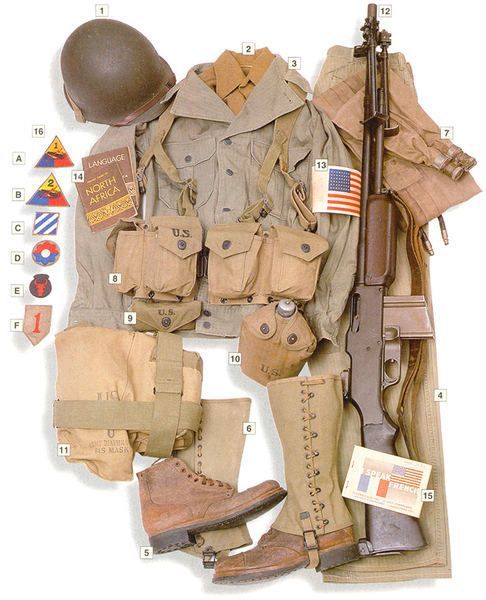
Kriegsmarine ( Navy) Matrosengefreiter, 1943 01 - naval jacket, Iron Cross Grade 2, veteran crew badge on the left side of the chest, Matrosengefreiter insignia 02 - Kriegsmarine cap 03 - naval peacoat 04 - "deck" trousers 05 - Signal magazine, July 1943 06 - tobacco 07 - cigarette paper 08 - "Hygenischer Gummischutz-Dublosan" 09 - boots
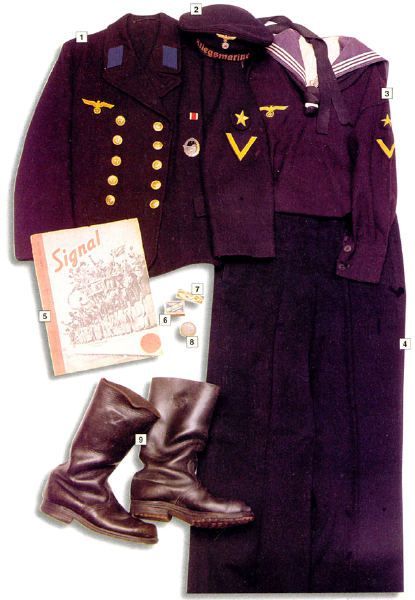
Major of the maintenance unit of the 1st Polish armored division, Germany, 1945 01 - M 37/40 everyday uniform 02 - black shoulder strap of the 1st armored division 03 - 1st Div badge 04 - Silver cross from Virtuti Militari 05 - M 37 shoulder straps 06 - 11.43 mm Colt M1911 pistol 07 - officer boots 08 - leather vest 09 - drivers gloves 10 - helmet for driving armored units "11 - AT Mk II motorcycle helmet 12 - Mk II helmet 12 - leggings
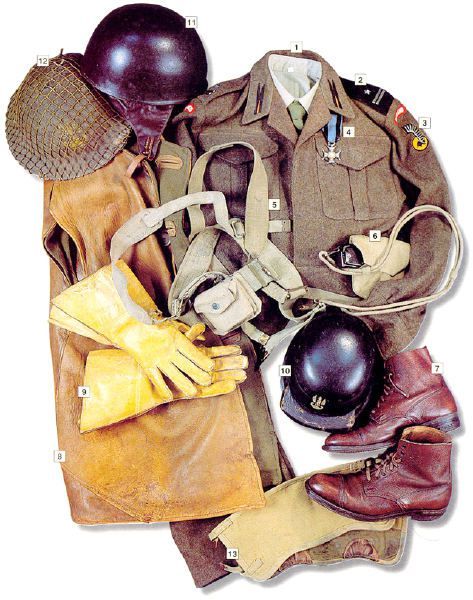
Private, Luftwaffe, France 1944 01 - M-40 helmet 02 - Einheitsfeldmütze M-43 garrison cap 03 - M-43 camouflaged T-shirt "Sumpftarnmuster" 04 - trousers 05 - shoulder straps 06 - 7.92 mm Mauser 98k rifle 07 - M-31 breadbag 08 - M-31 bowler hat 09 - M-39 boots 10 - medallion 11 - "Esbit" pocket heater

Lieutenant uniform, RSI "Decima MAS", Italy, 1943-44 01 - "Basco" beret 02 - Model 1933 helmet 03 - Model 1941 flight jacket, leutenant insignia on cuffs, badges on the cuffs 04 - German belt 05 - holster for Beretta 1933 and a pistol 06 - German M-24 grenade 07 - 9 mm TZ-45 SMG 08 - pouches 09 - trousers 10 - German mountain boots 11 - badge of participation in the "Folgore" company

8 SS-Kavallerie Division Florian Geyer, Summer 1944. 01 - М-40 Feldmutze cap 02 - М-40 helmet with CC badges 03 - field jacket 44 - new cut, cavalry badges on shoulder straps 04 - trousers 05 - М-35 belt 06 - wool shirt 07 - М-39 shoulder straps 08 - Florian Geyer armband 09 - woolen gloves 10 - Panzerfaust 60 11 - 7.92 mm Sturmgewehr 44 12 - M-84/98 bayonet 13 - canvas pouches 14 - M-24 grenade 15 - Waffen SS salary card 16 - M-31 bowler hat 17 - M-43 leather boots 18 - Leggings
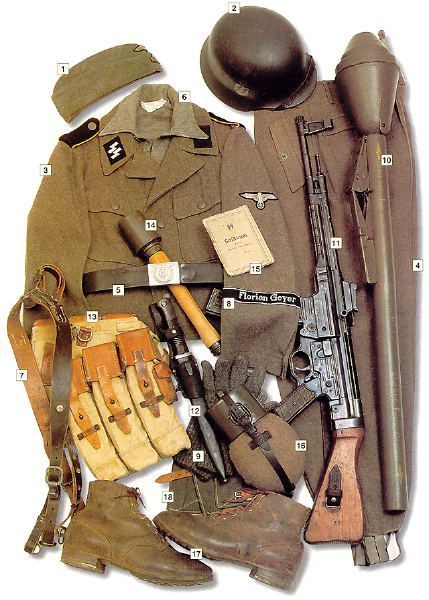
Captain (Kapitanleutnant) - submarine commander, 1941 01 - officer's jacket, Kapitanleutnant insignia 02 - Kninght Cross of the Iron Cross 03 - submarine sign 04 - Unofficial insignia of the 1st and 9th flotilla of submarines 05 - cigarette cap of the Kriegsmarine officers - 06 07 - leather gloves 08 - leather coat "U-Boot-Päckchen" 09 - boots 10 - "Junghans" 11 - naval binoculars

Partisan of the Peasant Battalion (Bataliony Chlopskie), Poland, 1942 01 - wz. 1937 "rogatywka" cap 02 - jacket 03 - trousers 04 - boots 05 - impromptu bandage 06 - 9 mm MP-40 SMG
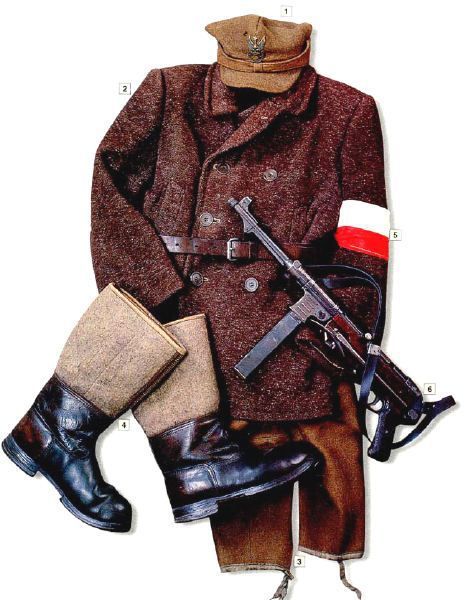
Uniform of the Soviet tank commander, 1939 01 - canvas hat with headphones 02 - model 1935 garrison cap with a red star 03 - linen overalls 04 - canvas bag for a gas mask 05 - officer boots 06 - holster for 7.62 mm Nagant 07 - leatherette tablet 08 - officer's belt
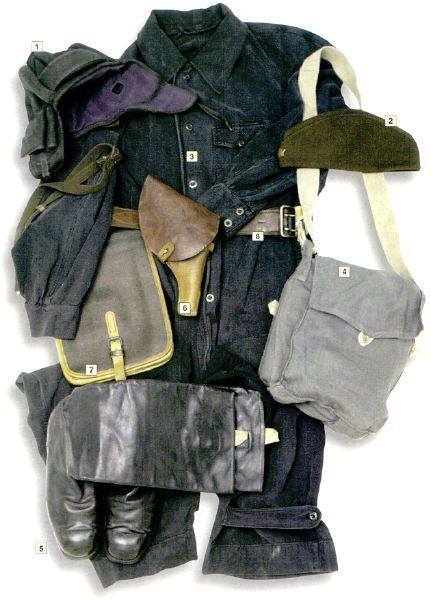
Polish infantry uniform 1939 01 - wz.1939 "rogatywka" cap 02 - wz.1937 "rogatywka" cap 03 - wz.1937 steel helmet 04 - wz.1936 jacket 05 - badge 06 - WSR wz.1932 gas mask in a canvas bag 07 - hygiene products 08 - leather pouches 09 - wz.1933 breadbag 10 - leather unloading belt 11 - wz.1938 bowler hat 12 - wz.1928 bayonet 13 - folding shovel in a leather case 14 - wz.1933 backpack with a blanket 15 - biscuits 16 - wz .1931 combi pot 17 - spoon + fork set 18 - owijacze fabric belts used instead of socks 19 - boots 20 - GR-31 frag grenade 21 - GR-31 offensive grenade 22 - 7.92 mm Mauser 1898a rifle 23 - 7 , 92 mm 24 - WZ clip. 1924 bayonet 25
A large assortment of military uniforms is presented in our online store. different countries and times. We are ready to provide you with a large assortment of goods among military paraphernalia, from buttonholes and shoulder straps to weapon dummies that completely repeat military counterparts.
Military uniform - implies various combat uniforms and equipment, primarily intended for the military and individuals, as well as all interested people. The first samples of military uniforms appeared in antique times in the form of armor. They not only made it possible to identify their troops, but also had protective function... The requirements have changed over time, for example, camouflage on the ground has become in demand, and the requirements for ease of use have also increased. For example, the color "khaki" was introduced during the Boer War to disguise soldiers. With the evolution of weapons, evolved and military uniform dictating new requirements. Each country has introduced its own standards and requirements for military uniforms. This has resulted in an abundance of choices in the market. To date, a huge number of different uniforms, equipment and other military paraphernalia are presented for review, starting with insignia and ending with multifunctional unloading systems, which you can purchase in our store.
The military uniform includes many elements. Elements such as uniforms, hats, shoes, backpacks, helmets, vests and other items designed for specific tasks have firmly taken their positions in the component of the uniform. . All this ammunition and military paraphernalia allow you to solve the task properly, it doesn't matter if it will be a reconstruction of soldiers Soviet army, or you need to collect a set of uniforms for hunting, and maybe for playing airsoft. And the variety of goods presented on our website will allow you to choose what you need, according to your hobbies. It can be like walking in the mountains in a comfortable shape and in high-quality, comfortable shoes. Also, the assortment of military paraphernalia is good gifts for men and for a themed holiday, for example, February 23 or Airborne Forces Day.
All military uniforms, which are presented in the assortment of our store, comply with market norms and necessary standards. Military uniform has high quality tailoring and materials of manufacture. Military paraphernalia is made according to production standards and norms. For example, field form soldiers of the Soviet army are made of 85% cotton, which meets the standards. All insignia correspond to the standard of the Armed Forces of the Russian Federation. MMGs are made of high-quality metal and fully replicate combat samples. Buying military paraphernalia and uniforms from us, you are guaranteed to receive quality and savings, both money and time.
- Expressive means of theater
- Scenario of an extra-curricular event "Day of Slavic Written Language and Culture" Events to celebrate the Day of Slavic Written Language and Culture
- Literature lesson dedicated to creativity B
- Summary of the lesson "Telling the fairy tale" Teremok
- Summary of the lesson "Telling the fairy tale" Teremok
- Lesson Topic: The Emergence of Art and Religious Beliefs
- New Fairy Tales VII - Writers' Union Literary Competition Fairy Tales of the Peoples of the World
- Characteristics of Katerina ("The Thunderstorm", Ostrovsky)
- Research work Formation of Nikita's character (based on the story of A
- Compositional features of the novel m
- Theme and idea of the story matrenin dvor
- Why did Sholokhov call the civil war a monstrous absurdity
- Composition based on the novel "Dubrovsky" A
- Composition based on the story live and remember Rasputin
- Quotes Tatyana Larina description of the heroine
- based on the novel Oblomov (Goncharov I
- The views of a simpleton. Who is Prostakov? Characteristics of the hero from the comedy "The Minor" by D. Fonvizin. Attitude to Sophia
- The image and character of Prostakova based on the comedy Minor (Fonvizin D
- Composition by A.I. Kuprin Life and work of Kuprin: a short description Features of Kuprin's creative manner
- "The symbolic meaning of the title of the story A









